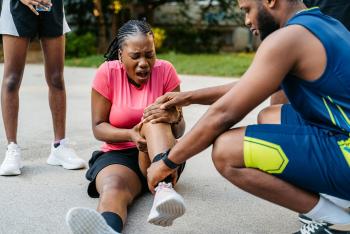Shoulder pain can result from injuries, arthritis or other conditions, and determining the right...
Read More

The man sitting next to you on the train is sporting a knee brace, and the lady to his left has her arm in a sling. You ask, and it turns out both of them got injured playing sports recreationally. You wonder if they could have prevented these injuries in any way. The short answer? Yes. Most common sports injuries are easily avoidable and treatable if you know what steps to take to prevent them and what signs to look for should they occur.
Here are three common adult sports injuries, and what you can do to avoid them.
Your ACL (anterior cruciate ligament) serves a variety of functions for your knee, including providing rotational stability and preventing your tibia (commonly known as your shinbone), from sliding out in front of your femur (commonly known as your thighbone), according to the American Academy of Orthopedic Surgeon (A.A.O.S.). Most often, injuries to the ACL are caused when taking part in sports that involve sudden stops and changes in direction of movement, such as football, basketball and soccer.
To avoid an ACL tear, wear properly fitting footwear, maintain adequate lower body strength and avoid playing sports such as football or soccer on artificial turf.
When your ACL tears, you’ll often hear a popping noise, and will feel immediate pain. It will become hard to bear weight on your leg, and your knee will begin to swell. You should seek further treatment from a medical professional immediately if you think you’ve torn your ACL. Treatment might include physical therapy, minimally invasive surgery or a combination of both.
Contradictory to tennis elbow’s name, this upper-body injury doesn’t just happen to tennis players. Anyone who uses their elbow and wrist in repetitive motions, such as cooks, painters and general laborers, can be susceptible to this painful condition. Tennis elbow develops with repeated use of your forearm muscles, which are used whenever you straighten or raise your wrist.
Exercises that strengthen your forearms can help to delay the onset of tennis elbow, including behind-the-back cable curls, chin-ups and fingertip pushups. Tennis elbow usually heals on its own, and over-the-counter medications, such as ibuprofen, can help to alleviate pain. Further treatment for severe cases can include physical therapy, plasma injections or ultrasonic tenotomy, a minimally invasive surgery.
When you suddenly increase the amount of pressure that you exert on your legs—often when in starting a new intensive workout program or running—you may develop shin splints. Soreness or pain, accompanied by mild swelling on the inside of your shinbone are usually indications that you’ve developed shin splints.
Typically, shin splints can be treated at home using the RICE method—rest, ice, compression and elevation. While this method is often encouraged for a variety of minor injuries, it can be particularly effective for shin splints as it emphasizes a steep reduction in the amount of pressure exerted on your shinbone.
If you’d like more information about our sports medicine program, or to schedule a consultation, call (856) 641-8000 ext. SPORT or email SportsMedicine@ihn.org.

Shoulder pain can result from injuries, arthritis or other conditions, and determining the right...
Read More
Strengthening your core after 40 is essential for improving your stability, balance and preventing...
Read More
From initial injury assessment to personalized recovery plans and advanced techniques, discover how...
Read More
The material set forth in this site in no way seeks to diagnose or treat illness or to serve as a substitute for professional medical care. Please speak with your health care provider if you have a health concern or if you are considering adopting any exercise program or dietary guidelines. For permission to reprint any portion of this website or to be removed from a notification list, please contact us at (856) 537-6772